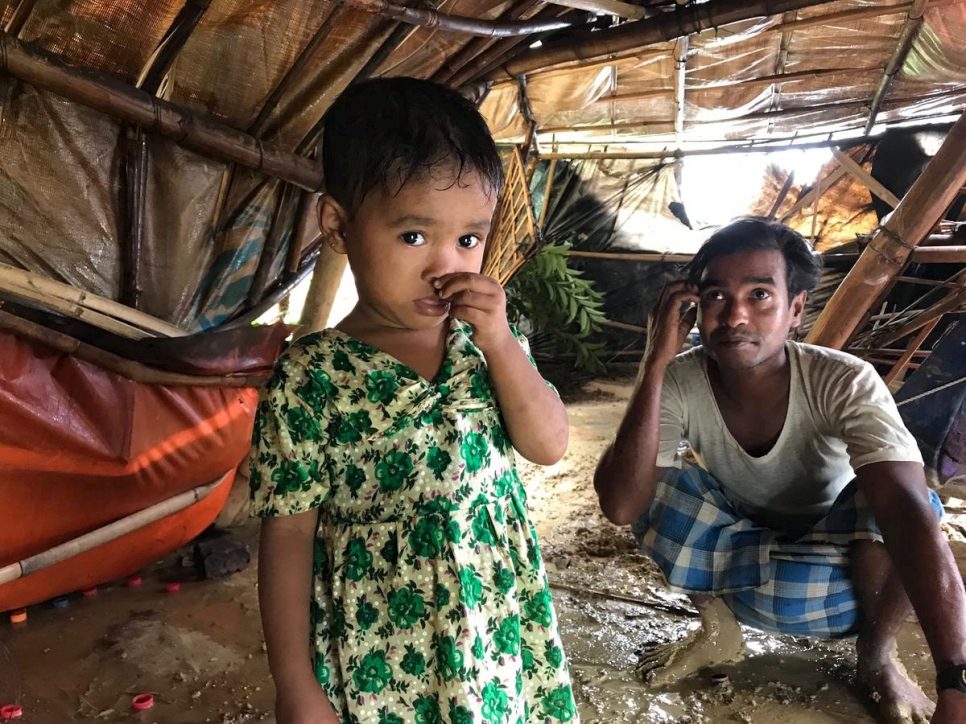Monsoon rains batter Bangladesh Rohingya refugee settlements
Winds and first heavy rains pound fragile landscape sheltering some 700,000 refugees, triggering landslides that killed one refugee and injured others amid ongoing emergency response.
Hasina Begum, 25, is a mother of four whose home was damaged by a landslide.
© UNHCR/Caroline Gluck
After two days of heavy rains and winds, mother-of-four Hasina Begum was feeding her children in the family’s bamboo and tarpaulin shelter, with her youngest, 10 day-old baby, Anwar Siddiq asleep in a cot, when she heard a loud noise.
Large parts of the hillside collapsed in an instant, battering the shelter and breaking bamboo support beams. Some soil swept on to baby Anwar’s cot which had been swaying by a rope from the roof.
“We were terrified. I thought we would die,” she says, speaking at a school where she is now staying with three other families. “If this had happened at night, we might not have made it out alive,” she adds, nursing sleeping baby Anwar in her arms. “It’s a miracle he’s alive – thanks to Allah”.
Hasina and her family are among 26 households in Chakmarkul, that have so far had to be relocated due to landslides since heavy rains began on Sunday, dumping more than 100 milimetres of water in one 24-hour period alone, as winds of up to 70 kilometres per hour buffeted shelters.
“We were terrified. I thought we would die."
Driving rain has caused at least 89 reported incidents, including 37 landslides that killed one refugee and injured others. Nearly 2,500 refugee families – a total of more than 11,000 people – have so far been affected. The area of the site were Hasina and her family are living was particularly badly-hit, with 17 families in her block having to move because of landslides.
For months, UNHCR, the UN Refugee Agency, and its partners, have worked around the clock in support of the Government of Bangladesh, to mitigate the risks. Teams have put in new bridges, built drainage canals, strengthened footpaths and provided over 83,000 families with upgraded shelter kits so they can better protect themselves. More than 30,000 famlies have have also received pre-monsoon “tie down” kits, consisting of rope and steel pegs, to better anchor their shelters in high winds. More will be distributed in coming days.
Chakmarkul is one of the smaller Rohingya settlements, housing around 13,000 Rohingya refugees. But it is also one of the most risky due to its hilly topography and low-lying areas, making people here highly vulnerable to both landslides and flooding. To get to his family’s shelter, Hasina’s husband, Md. Rafiq, 29, navigates narrow muddy pathways carved out of the hillside.

Md. Rafiq with his two-year-old daughter at their house that was damaged by a landslide. © UNHCR/Caroline Gluck
Pounded by the rains, pathways and stairs have developed cracks or broken away; hillsides have crumbled and many latrines were precariously slanted on hillsides. In the remains of Md. Rafiq’s home, large beams have collapsed and are leaning sideways; and the bamboo and tarpaulin sides of the shelter have caved in.
“We can’t move back here,” he says. “We need to move to another place – a safe place. I’m afraid this might happen to us again, I’m afraid that the hill will fall onto us.”
Some 150,000 to 200,000 refugees are estimated to be living in areas that are vulnerable to landslides, floods, or both. Of the 41,000 refugees assessed to be at highest risk of landslides, more than 14,000 have so far been relocated to safer areas. Finding additional flat land is a huge challenge, due to the hilly terrain in Cox’s Bazar district.
This is just the start of the monsoon season, which peaks through the start of September. A few days of very heavy rain have already had a punishing impact on the fragile environment in the refugee settlements in Cox’s Bazar district where more than 720,000 Rohingya refugees who fled violence in Myanmar since last August, are sheltering.
Families are becoming jittery, but trying to do what they can to make their shelters more robust. At the settlement, one man wearing a translucent plastic bag on his head as a rain hat collected sandy soil in a metal bowl to try to compact the side of the hill supporting his shelter.
“This is my house,” a man calls out from the pathway in English. He points to one shelter perched on the edge of land which looks like it is about to collapse. Water flows quickly along a channel below. “Last night and the previous night, the whole night we couldn’t sleep,” explains 23 year-old Md. Ibrahim. “There is the mountain. We are afraid of landslides. We are afraid for our lives.”
“We have to move,” he insists. “We can’t live any more here.”
